Search the Special Collections and Archives Portal
Search Results
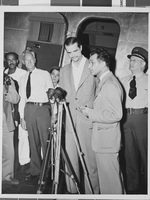
Photograph of Howard Hughes, New York, New York, September 12, 1946
Date
1946-09-12
Archival Collection
Description
Description given with photo: "Hughes Arrives In New York: La Guardia Field, New York, N.Y. -- Completing his first air journey since his near-fatal test-flight accident July 7, Howard Hughes, airplane designer, pilot and movie producer, is interviewed by reporters after piloting his converted B-23 transport to a midnight landing here tonight at La Guardia Field. Hughes interrupted his convalescence to fly here from Culver City, Calif., with a stop-over in Kansas City. In New York, Hughes planned to cover with his attorneys regarding steps to protect his property rights in connection with the motion picture, "The Outlaw", which recently had its seal of approval revoked by the Motion Picture Association."
Image
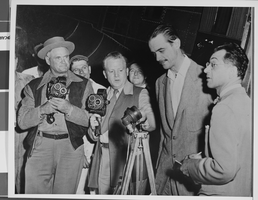
Photograph of Howard Hughes, New York, New York, September 12, 1946
Date
1946-09-12
Archival Collection
Description
Description given with photo: "Hughes Arrives In New York: La Guardia Field, New York, N.Y. -- Completing his first air journey since his near-fatal test-flight accident July 7, Howard Hughes, airplane designer, pilot and movie producer, is interviewed by reporters after piloting his converted B-23 transport to a midnight landing here tonight at La Guardia Field. Hughes interrupted his convalescence to fly here from Culver City, Calif., with a stop-over in Kansas City. In New York, Hughes planned to cover with his attorneys regarding steps to protect his property rights in connection with the motion picture, "The Outlaw", which recently had its seal of approval revoked by the Motion Picture Association."
Image
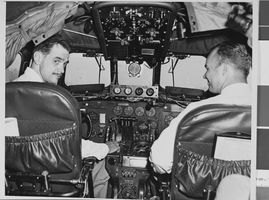
Photograph of Howard Hughes installing radar, Culver City, California, May 03, 1947
Date
1947-05-03
Archival Collection
Description
Description given with photo: "Hughes Pilots Radar-Equipped Plane Culver City, Calif. -- First passenger plane equipped with radar is flown in demonstration May 1st by Howard Hughes (left) and co-pilot R.C. Loomis over Culver City. Pilots using this equipment will be warned of approaching obstacles by lights flashing on radar panel. Two lights (lefts) with 2,000-foot range, are used to guarantee clearance over mountains; two lights (right) with 500-foot range, are a safety device for approaches and landings. Either set of lights warns against approaching aircraft. Trans-World Airline plans to install radar on its passenger planes. Credit (ACME) 5-3-47."
Image
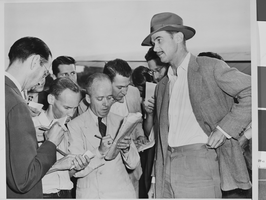
Photograph of Howard Hughes with reporters, Washington, August 06, 1947
Date
1947-08-06
Archival Collection
Description
Description given with photo: "102,246 - Watch Your Credit - International News Photo. Slug - (Howard Hughes) Hughes Ready For Senate Investigators, Washington, D.C. Howard Hughes, right, is interviewed by reporters at Washington National Airport after his arrival in a converted B-23 bomber from Culver City, X California. Hughes, there to face Senate Investigators, said he would be "most happy" to repeat under oath charges he has made against chairman Owen Brewster, (R) of Me., of the Senate War Investigating Committee now probing his wartime plane contracts. -Photo by G.B. Kress- 8/6/47."
Image
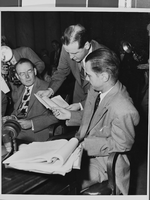
Photograph of Howard Hughes at hearing, Washington, August 08, 1947
Date
1947-08-08
Archival Collection
Description
Description given with photo: "102,266 - Watch Your Credit - International News Photo. Slug - (Slack-Flanagan-Hughes) War Probers Subpoenaed Hughes' Private Papers, Washington, D.C. Senate War Investigating Committee counsel Francis Flanagan, center, is shown as he presented a subpoena issued by sub-committee chairman Homer Ferguson, (R) of Mich., directing Howard Hughes, right, to produce all private records connected with the Hughes wartime aircraft contract inquiry. Thomas A. Slack, counsel for Hughes, is at left. -INP Photo by G.B. Kress- 8/8/47."
Image
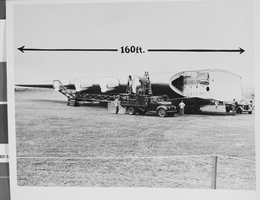
Photograph of the construction of Howard Hughes' Hercules, June 12, 1946
Date
1946-06-12
Archival Collection
Description
Description given with photo: "Prepare to Move "Hercules" Wing, Culver City, Calif. -- One of the two 34-ton wing sections of Howard Hughes' eight-engined Hercules, world's largest flying boat, is put on house-moving dollies in Culver City, Calif., before beginning the 28-mile journey to Los Angeles Harbor, where the mammoth airplane will be assembled for its first test flight, supposedly around the first of the year. A two-day trip will see the wing- 19 feet high, 49 feet wide, 160 feet long - at the $200,000 graving dock at Terminal Island, Calif., which was built specifically for the assembly of the craft. Note comparative size of men working on the wind. Credit (ACME). 6-12-46."
Image
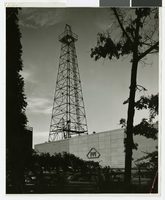
Photograph of the exterior of Hughes Research Laboratories, Culver City, California, circa 1940s
Date
1940 to 1949
Archival Collection
Description
The exterior of Hughes Research Laboratories where rock bits were test-drilled in Culver City, California in the 1940s. Transcribed from note taped to back of photo: "Rock bits are test-drilled in the laboratory under conditions that duplicate, as far as is possible in the laboratory, those encountered in actual drilling. As a result, rotational speeds, loads, and fluid volume are closely controlled. The rig operator occupies a splash-proof booth above the 'cellar floor.' The instruments on his control panel provide for application and measurement of variable axial loading on the drilling bit up to 100,000 lbs., variable rotational speeds up to 400 rpm, measurement of bit penetration over a total vertical travel of 5 feet at rates up to 180 ft. per hour, and torque. On the panel, also, are several controls for the operation of mud pump and other accessory equipment."
Image
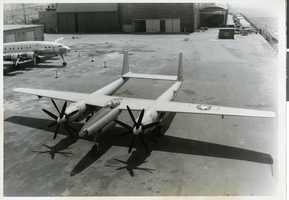
Photograph of the XF-11 prior to its first test flight in Culver City, California July 7, 1947
Date
1947
Archival Collection
Description
Transcribed from press release attached to back of photo: "NEW-DESIGN PHOTO PLANE COMPLETED CULVER CITY, Calif., July 7 -- test-flown today for the first time, the new XF-11 was revealed as one of the world's fastest long-range photographic planes. It was designed and built by Howard Hughes in conjunction with the Air Materiel command engineers. Army officials said that it can attain a speed of more than 400 miles per hour and a ceiling of more than 40,000 feet. The plane has a pressurized cabin making it unnecessary for the crew to use oxygen masks. Outstanding features include a full-span flap, unique eight-camera layout and exceptionally fast take-off." Transcribed from photo sleeve: "Howard Hughes sits in the cockpit of the XF-11, a reconnaissance plane that Hughes built and designed in conjunction with Air Materiel Command engineers. Hughes is preparing for his first test flight in Culver City, California July 7, 1947."
Image
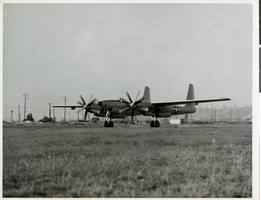
Photograph of the XF-11 as it is about to take off for its first test flight in Culver City, California July 7, 1947
Date
1947
Archival Collection
Description
Transcribed from attachment to photo: "NEW LONG-RANGE PLANE ANNOUNCED CULVER CITY, CALIF., The FX-11 took off today on its first test flight. One of the world's fastest long-range photographic planes, it was designed and built by Howard Hughes in conjunction with Air Materiel Command engineers. It has a wing spread of 101 feet, 4 inches, and is powered by two 3000-horsepower radial engines with eight-bladed contra-rotating propellers. Army officials said it can attain a speed of more than 400 miles per hour and has a ceiling of more than 40,000 feet." Transcribed from photo sleeve: "Howard Hughes sits in the cockpit of the XF-11, a reconnaissance plane that Hughes built and designed in conjunction with Air Materiel Command engineers. Hughes is preparing for his first test flight in Culver City, California July 7, 1947."
Image
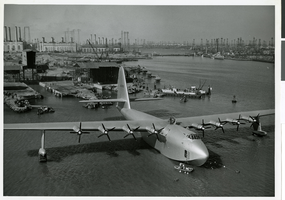
Aerial view of Hughes Flying boat launched, November 1, 1947, in preparation for the historic test flight, November 2 , 1947
Date
1947-11-01
Archival Collection
Description
Aerial view of Hughes Flying boat. Press release attached to back of photo: "LAUNCHING WORLD'S LARGEST PLANE The Hughes Flying boat was launched for the first time November 1, 1947. After the three concrete docks, one containing the hull and two the wing pontoons, were pumped with sea water to the outside level, gates were lowered and the Flying Boat was carefully towed forward by tractors, and by boats as the tail cleared the dock. During taxi tests the following day Howard Hughes made a surprise flight of a mile." Stamped on back of photo: "Hughes Aircraft Photo" and the date "Nov 1 1947." Los Angeles Harbor, Terminal Island are now known as Long Beach.
Image
Pagination
Refine my results
Content Type
Creator or Contributor
Subject
Archival Collection
Digital Project
Resource Type
Year
Material Type
Place
Language
Records Classification
